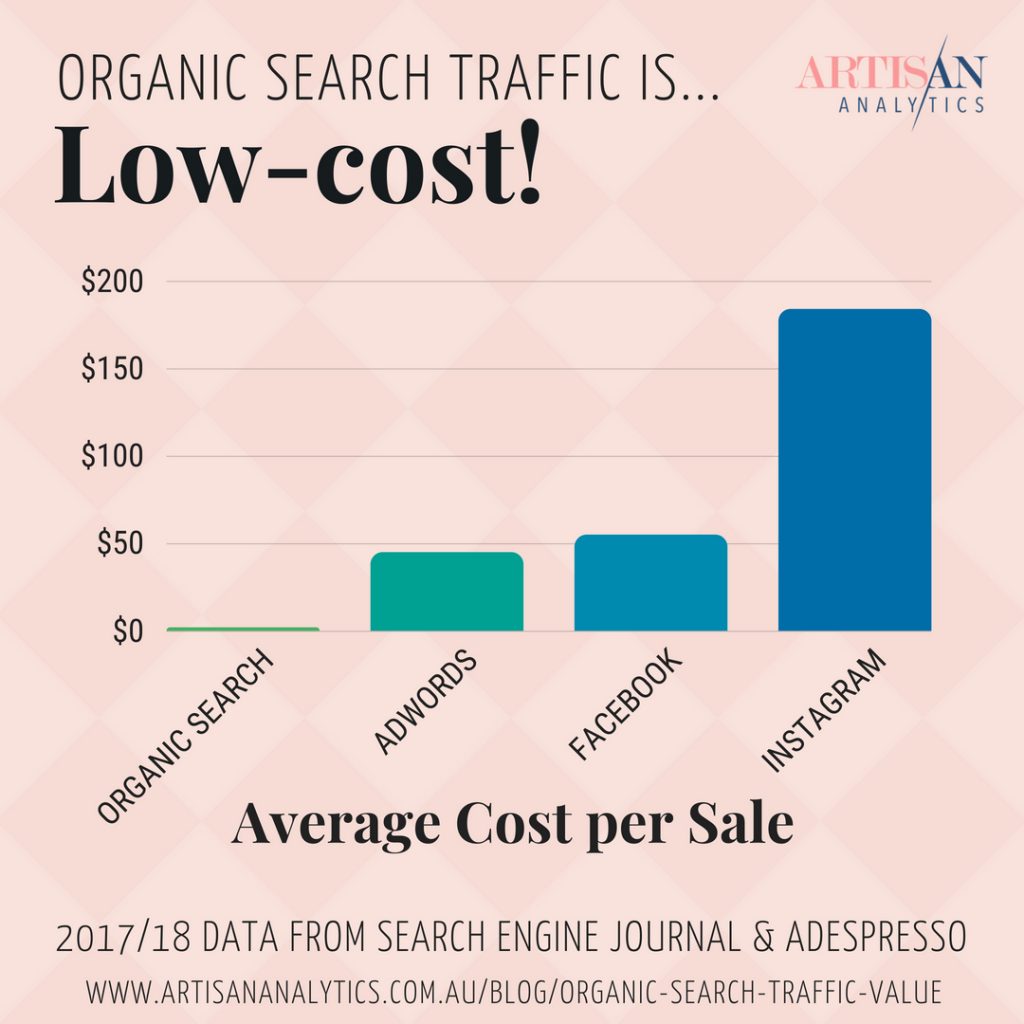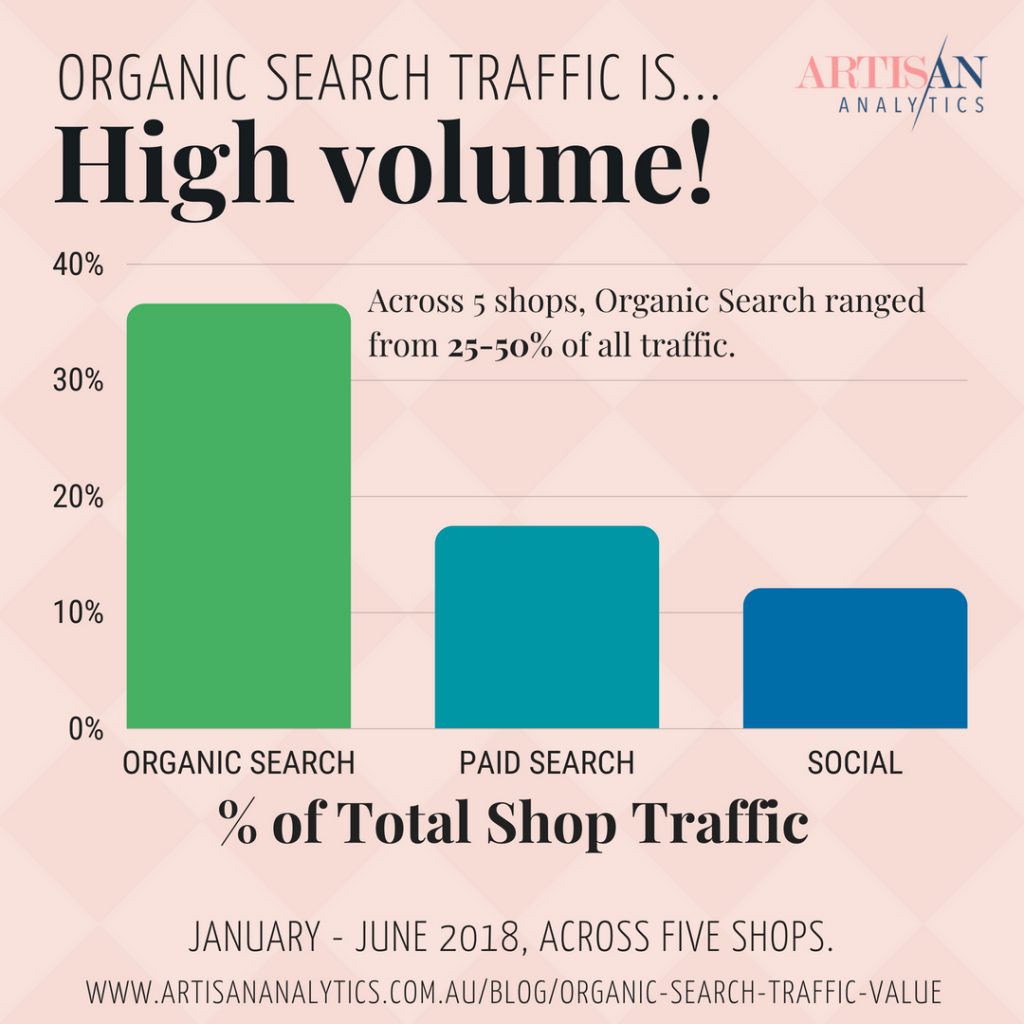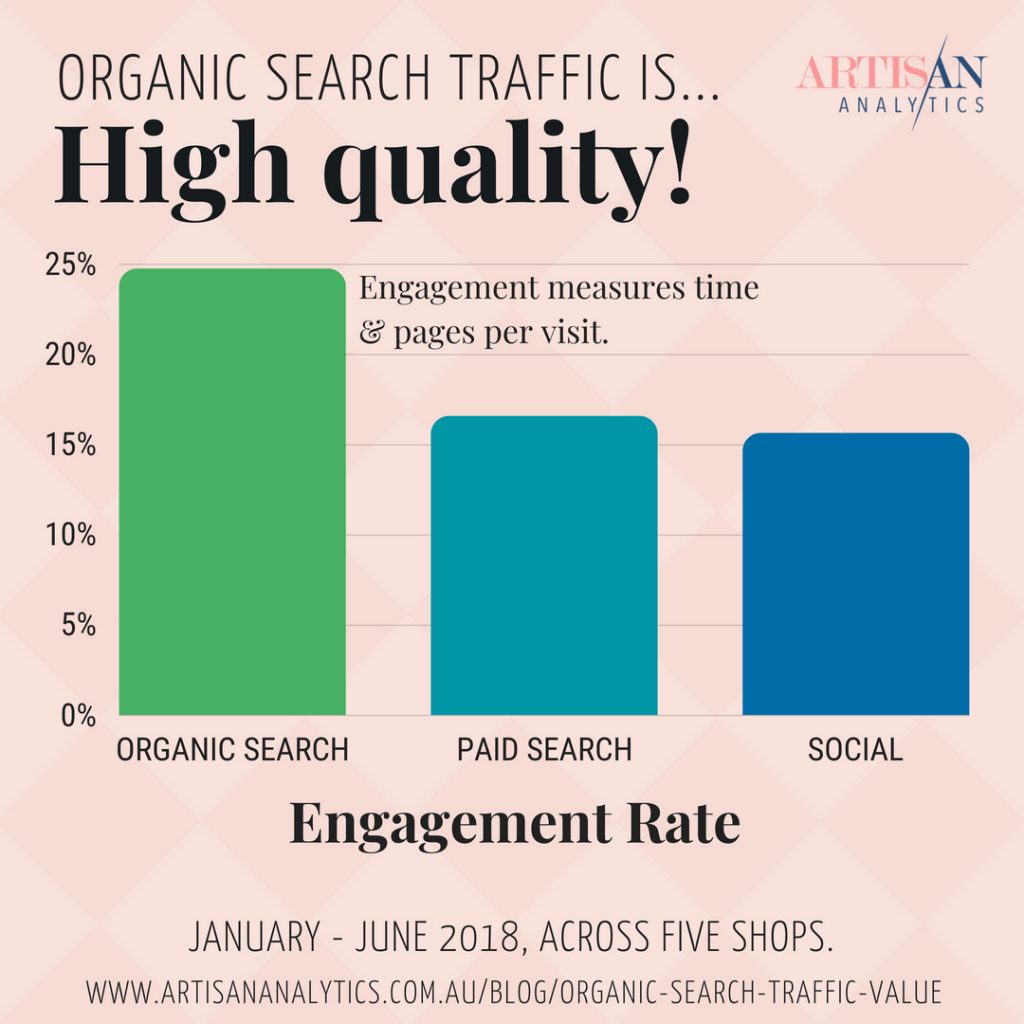Years ago, almost all of my clients also partnered with a Search Engine Optimization agency.
Google was king and SEO was strategy #1.
Then social media marketing took over as businesses discovered the value of free exposure on Facebook and Twitter. The results were faster and it was no harder than SEO.
Now it’s 2018 2023. Organic reach on social media is still a shadow of its former self. Advertising costs on the major networks (AdWords and Facebook) are doubling every year. And AI chatbots are loudly heralding the return of the king: search is back – and this time, it’s smarter!
If your marketing strategy is getting more complicated and expensive every month, it’s time to re-discover the value of organic search traffic.
What is Organic Search traffic?
Organic Search traffic is any set of visits to your website where:
- You do not pay-per-click or pay to be displayed in the results. (You might pay to use the platform as a whole.)
- The visitor freely entered a search phrase to bring up your shop or product in the results for that phrase.
This includes visitors from Google (obviously), Bing and other search engines. In our world of boutique ecommerce, it also includes potential customers searching on marketplaces like Etsy, Amazon or ebay and clicking the organic (not sponsored) search results.
Pinterest should even be included as a search engine! However, the data in this article puts it into Social, as that’s how most other reports and Google Analytics categorize it.
In most cases, the benefits of organic search traffic apply to all of these sources.
1. Search is a sustainable channel
With search traffic, you don’t have to keep paying money for clicks or to post every single day.
Don’t get me wrong – advertising and social are valuable. In fact, the brand awareness that ads generate can directly contribute to your organic search traffic!
But when you pause a campaign, the traffic stops dead.
If you stop spending hours a week writing social media posts and taking Instagram photos, the traffic dries up.
Search traffic is different. It takes a while to build up, but once there, you won’t suddenly lose it all because you missed posting a blog article or didn’t release any new products for a month. A little bit of maintenance goes a long way!
What happens if you stop updating your website?
Here’s my organic Google traffic trends for March – July 2018, for Artisan Analytics. I rely on writing blog articles to attract search traffic, so what happens in between my posts?

The red squares highlight weeks when I posted nothing new to my website. My search traffic didn’t drop off at all!
Posting new articles increases my traffic, but reasonably short gaps in posting does not decrease it. It simply limits my growth.
2. Organic search is (very) low cost
There are paid SEO services, but once you learn the basics (whether you start with an expert’s help or not), you can continue to get regular traffic without spending hundreds or thousands of dollars a month – like you can on advertising!
Regular checkups are a good idea, like anything, but it’s not a 50-bucks-a-day investment.
Instead, an annual $500 professional audit that kept your shop attracting between 1,000 – 1,500 organic search visits per month could average out to well under $2 per sale.
Do it all yourself (and get results you’re happy with) and that cost plummets to zero.
What do you pay for an ad-driven sale?
Your cost per acquisition (CPA) also eats into your profit margin. That’s your total ad spend divided by the sales you made from those ads. $100 spend that made 2 sales = $50 CPA.
$50 might sound like a lot to pay to sell one of your items, but it’s not unrealistic.
- In 2018, $45 is a very average CPA for ecommerce AdWords. Read the full article on Search Engine Journal.
- Across 2017, cost-per-click on Instagram ads targeting US users was $3.68. With a very respectable 2% conversion rate, your shop would pull a CPA of $184. Read the full article on AdEspresso.
- Facebook ads targeting US users averaged a slightly more palatable cost-per-click of $1.10, for 2017. At 2% conversion, that’d be a $55 CPA. Read the full article on AdEspresso.
(Kind of makes Etsy’s 15% for Offsite Ads sound good in comparison, doesn’t it?)
What does “cost per acquisition” really mean?
Put simply: CPA is your daily budget if you want to average one sale per day from that campaign.

3. You get lots of search traffic
Organic search often sends between 30-40% of a shop’s total traffic.
It can be even more, if you don’t do a lot of other marketing or if you include Pinterest in your “Organic Search” channel.
A lot of low cost & low effort traffic means that even if the conversion rate isn’t amazing, the sheer number of visitors will still result in plenty of sales for very low input. (If it’s not doing this for you, check what keywords you’re ranking for.)
High traffic volume is also great for your analytics. It’s a lot easier to work out reliable, statistically significant averages over lots of traffic, like for engagement or conversion rates.

3. People search when they want something
People search when they want something and they search for what they want.
It might sound stupidly simple, but here’s what this means:
1. Searchers are actively looking for something: information, reviews, comparisons or a product to buy. They aren’t idly scrolling Instagram or reading someone else’s blog article, in a totally different mindset.
This means that as long as your search result is relevant, the searcher is already interested in your topic or type of product. All you have to compete with are the other search results. You don’t have to convince them to be interested in what you have to show them.
2. Searchers explicitly say what they want: they type in a search phrase. Some search engines customize results for each user, but they are not returning all their results based entirely on assumed demographics or past behaviour.
These both result in search visitors being better engaged, higher quality visitors – second only to people who already have a relationship with you (customers on social, email subscribers etc.).

4. Search phrases give you great insights
Search term data is a goldmine! It’s a list of real words that real people use to describe your product: which is a product-description-writer’s dream.
It’s also the perfect place to start learning about your customer’s values, why they’re buying and other products they might be interested in.
How to see your search term data
Etsy Search data: Use Etsy Shop Stats, Etsy Search Analytics or configure Google Analytics to record your Etsy search phrases.
Google Search Console: If you run your own website, use Google Search Console to view search terms visitors use on Google. You cannot use this with Etsy.
5. Good Google-SEO makes for a good user experience
Search engine optimization today is worlds away from the “keyword stuffing” days. Instead, Google includes plenty of “ranking factors” (criteria by which to measure and rank your website) that put user experience first:
- Loads fast
- Mobile friendly
- Secure
- Easy to read
- Easy to navigate
- No broken links
- No overwhelming or distracting ads
Apart from these very specific factors, Google’s entire ranking focus is all about showing the most useful and credible results. Who doesn’t want that?
When you focus on these elements of SEO, you end up with a shop that’s better for your users too!
Learn more about 200 of Google’s ranking factors on Backlinko.
6. Search traffic is perfect for comparing!
Analytics is all about comparing (or segmentation).
If search traffic is low-cost and performs kinda… average, then clearly any marketing you put more effort and money into should give you even better results than organic search. Search traffic becomes your benchmark.
It’s not influenced by your marketing pattern
If you go on holidays for a week, your search traffic keeps coming. If you change your Instagram style or start sending a new type of email, your search visits won’t change much. Instead, search traffic tends to reflect wider trends that affect all shops, like trends, the seasons or the economy.
This level of “independence” from the rest of your marketing makes it great “control” traffic to compare your other marketing activities to.
Your next step: Get started (or keep going) with SEO
SEO for every ecommerce store
- Beginner’s Guide to Ecommerce SEO (Shopify)
- Advanced guide to ecommerce SEO + case study (Backlinko)
SEO for Etsy
- How Etsy Search Works (Etsy Help)
- Understanding Etsy SEO: Complete Guide (Tizzit)
SEO for Amazon (including Amazon Handmade)
- Optimize your Amazon product listings (HigherVisibility)
- Guide to Amazon SEO (BigCommerce)
